The Enduring US-Australian Alliance: Shared Interests and Traditions
VerifiedAdded on 2020/03/16
|6
|1534
|47
Essay
AI Summary
This essay examines the enduring US-Australian alliance, a cornerstone of Australian foreign policy since World War II. It explores whether this alliance is primarily based on shared interests or historical tradition, tracing its origins to the Second World War when Australia sought security from the United States after facing Japanese threats. The essay analyzes the ANZUS Treaty, the benefits for both countries, and the strategic implications of the alliance, particularly in the context of post-9/11 security concerns and the 'war on terror.' It also discusses the economic aspects, including trade relations and the US's role in the Australian economy, as well as the evolving defense capabilities of Australia and its reliance on US military technology and intelligence. The essay concludes by highlighting the shared interests in security and economic advantage, while also acknowledging the potential for Australia's foreign policy to be influenced by US global priorities.
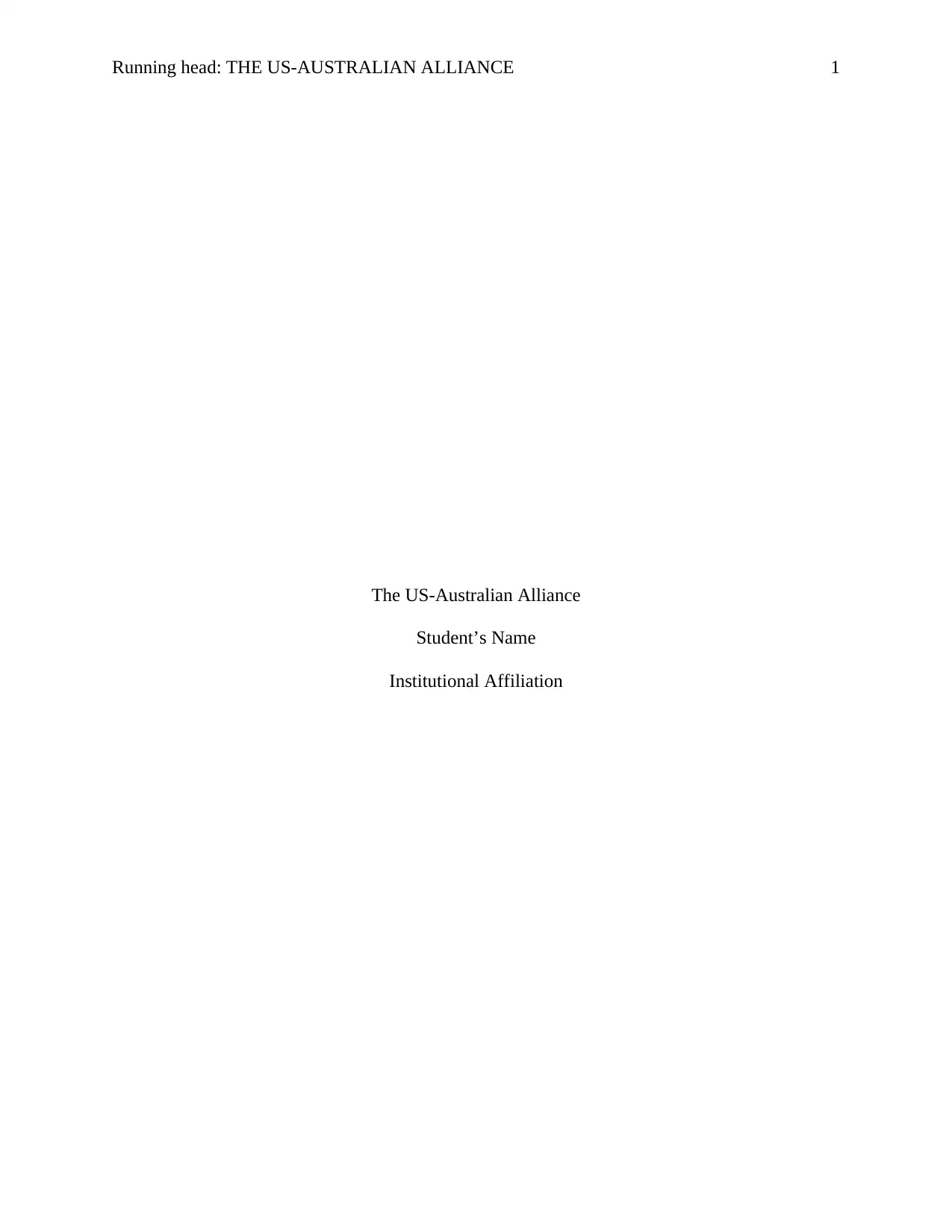
Running head: THE US-AUSTRALIAN ALLIANCE 1
The US-Australian Alliance
Student’s Name
Institutional Affiliation
The US-Australian Alliance
Student’s Name
Institutional Affiliation
Paraphrase This Document
Need a fresh take? Get an instant paraphrase of this document with our AI Paraphraser
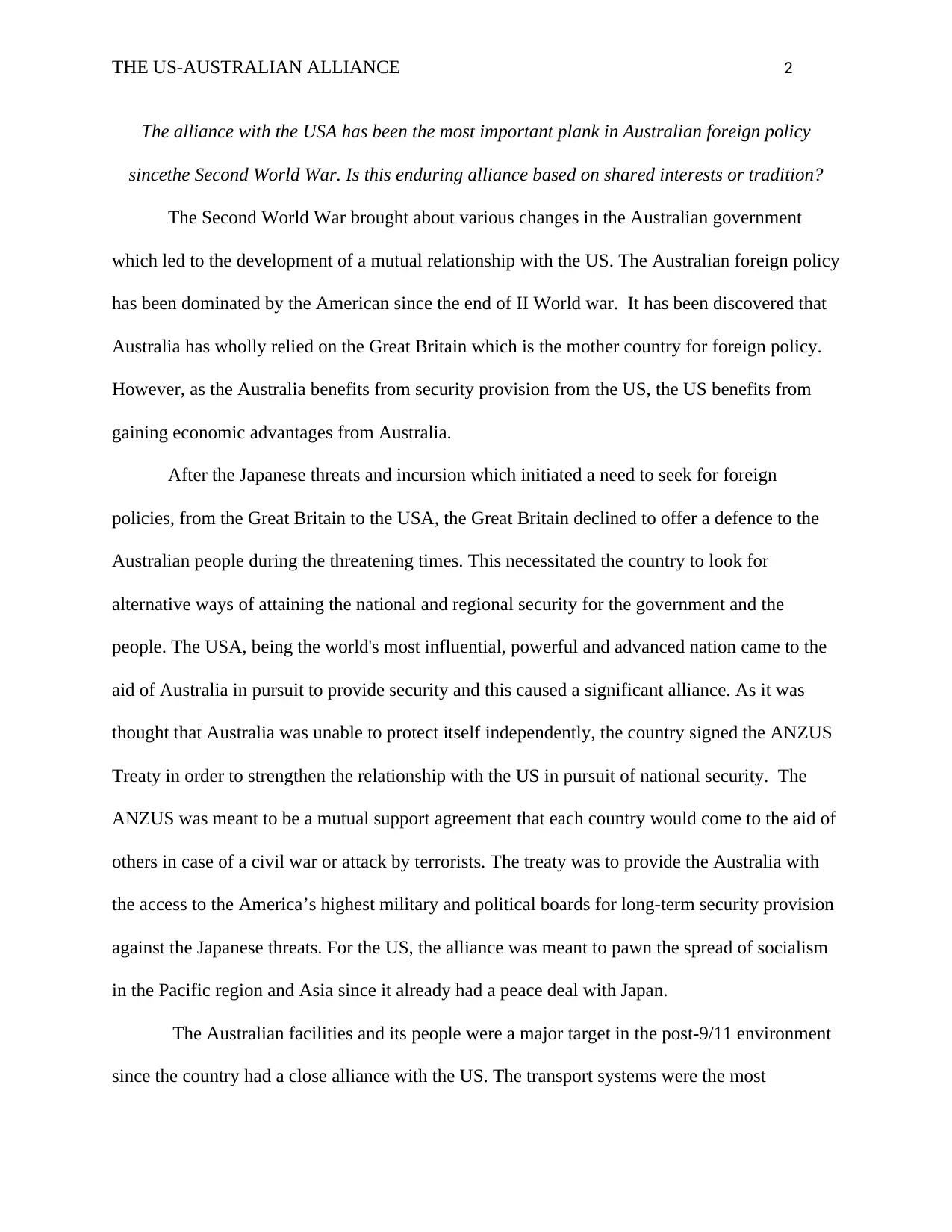
THE US-AUSTRALIAN ALLIANCE 2
The alliance with the USA has been the most important plank in Australian foreign policy
sincethe Second World War. Is this enduring alliance based on shared interests or tradition?
The Second World War brought about various changes in the Australian government
which led to the development of a mutual relationship with the US. The Australian foreign policy
has been dominated by the American since the end of II World war. It has been discovered that
Australia has wholly relied on the Great Britain which is the mother country for foreign policy.
However, as the Australia benefits from security provision from the US, the US benefits from
gaining economic advantages from Australia.
After the Japanese threats and incursion which initiated a need to seek for foreign
policies, from the Great Britain to the USA, the Great Britain declined to offer a defence to the
Australian people during the threatening times. This necessitated the country to look for
alternative ways of attaining the national and regional security for the government and the
people. The USA, being the world's most influential, powerful and advanced nation came to the
aid of Australia in pursuit to provide security and this caused a significant alliance. As it was
thought that Australia was unable to protect itself independently, the country signed the ANZUS
Treaty in order to strengthen the relationship with the US in pursuit of national security. The
ANZUS was meant to be a mutual support agreement that each country would come to the aid of
others in case of a civil war or attack by terrorists. The treaty was to provide the Australia with
the access to the America’s highest military and political boards for long-term security provision
against the Japanese threats. For the US, the alliance was meant to pawn the spread of socialism
in the Pacific region and Asia since it already had a peace deal with Japan.
The Australian facilities and its people were a major target in the post-9/11 environment
since the country had a close alliance with the US. The transport systems were the most
The alliance with the USA has been the most important plank in Australian foreign policy
sincethe Second World War. Is this enduring alliance based on shared interests or tradition?
The Second World War brought about various changes in the Australian government
which led to the development of a mutual relationship with the US. The Australian foreign policy
has been dominated by the American since the end of II World war. It has been discovered that
Australia has wholly relied on the Great Britain which is the mother country for foreign policy.
However, as the Australia benefits from security provision from the US, the US benefits from
gaining economic advantages from Australia.
After the Japanese threats and incursion which initiated a need to seek for foreign
policies, from the Great Britain to the USA, the Great Britain declined to offer a defence to the
Australian people during the threatening times. This necessitated the country to look for
alternative ways of attaining the national and regional security for the government and the
people. The USA, being the world's most influential, powerful and advanced nation came to the
aid of Australia in pursuit to provide security and this caused a significant alliance. As it was
thought that Australia was unable to protect itself independently, the country signed the ANZUS
Treaty in order to strengthen the relationship with the US in pursuit of national security. The
ANZUS was meant to be a mutual support agreement that each country would come to the aid of
others in case of a civil war or attack by terrorists. The treaty was to provide the Australia with
the access to the America’s highest military and political boards for long-term security provision
against the Japanese threats. For the US, the alliance was meant to pawn the spread of socialism
in the Pacific region and Asia since it already had a peace deal with Japan.
The Australian facilities and its people were a major target in the post-9/11 environment
since the country had a close alliance with the US. The transport systems were the most
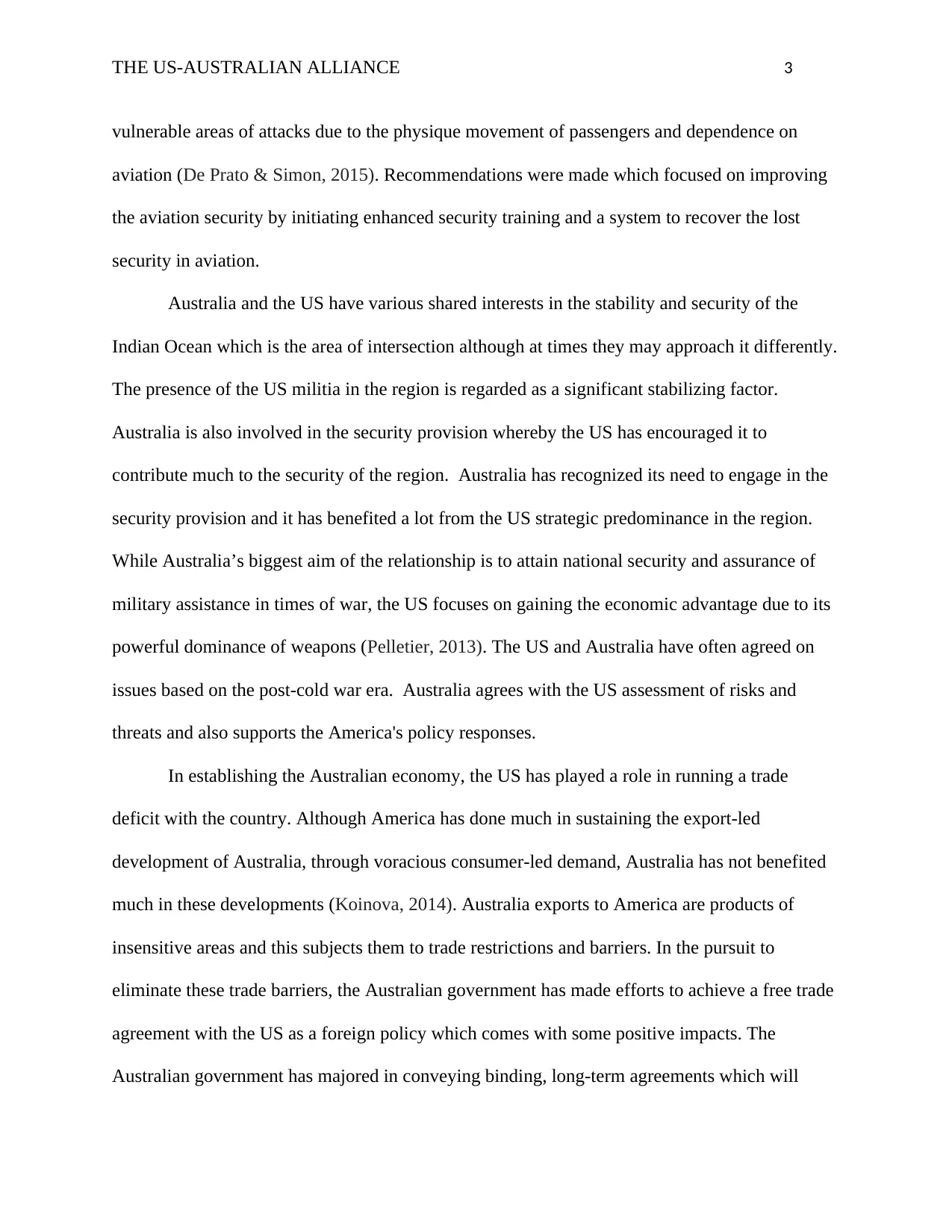
THE US-AUSTRALIAN ALLIANCE 3
vulnerable areas of attacks due to the physique movement of passengers and dependence on
aviation (De Prato & Simon, 2015). Recommendations were made which focused on improving
the aviation security by initiating enhanced security training and a system to recover the lost
security in aviation.
Australia and the US have various shared interests in the stability and security of the
Indian Ocean which is the area of intersection although at times they may approach it differently.
The presence of the US militia in the region is regarded as a significant stabilizing factor.
Australia is also involved in the security provision whereby the US has encouraged it to
contribute much to the security of the region. Australia has recognized its need to engage in the
security provision and it has benefited a lot from the US strategic predominance in the region.
While Australia’s biggest aim of the relationship is to attain national security and assurance of
military assistance in times of war, the US focuses on gaining the economic advantage due to its
powerful dominance of weapons (Pelletier, 2013). The US and Australia have often agreed on
issues based on the post-cold war era. Australia agrees with the US assessment of risks and
threats and also supports the America's policy responses.
In establishing the Australian economy, the US has played a role in running a trade
deficit with the country. Although America has done much in sustaining the export-led
development of Australia, through voracious consumer-led demand, Australia has not benefited
much in these developments (Koinova, 2014). Australia exports to America are products of
insensitive areas and this subjects them to trade restrictions and barriers. In the pursuit to
eliminate these trade barriers, the Australian government has made efforts to achieve a free trade
agreement with the US as a foreign policy which comes with some positive impacts. The
Australian government has majored in conveying binding, long-term agreements which will
vulnerable areas of attacks due to the physique movement of passengers and dependence on
aviation (De Prato & Simon, 2015). Recommendations were made which focused on improving
the aviation security by initiating enhanced security training and a system to recover the lost
security in aviation.
Australia and the US have various shared interests in the stability and security of the
Indian Ocean which is the area of intersection although at times they may approach it differently.
The presence of the US militia in the region is regarded as a significant stabilizing factor.
Australia is also involved in the security provision whereby the US has encouraged it to
contribute much to the security of the region. Australia has recognized its need to engage in the
security provision and it has benefited a lot from the US strategic predominance in the region.
While Australia’s biggest aim of the relationship is to attain national security and assurance of
military assistance in times of war, the US focuses on gaining the economic advantage due to its
powerful dominance of weapons (Pelletier, 2013). The US and Australia have often agreed on
issues based on the post-cold war era. Australia agrees with the US assessment of risks and
threats and also supports the America's policy responses.
In establishing the Australian economy, the US has played a role in running a trade
deficit with the country. Although America has done much in sustaining the export-led
development of Australia, through voracious consumer-led demand, Australia has not benefited
much in these developments (Koinova, 2014). Australia exports to America are products of
insensitive areas and this subjects them to trade restrictions and barriers. In the pursuit to
eliminate these trade barriers, the Australian government has made efforts to achieve a free trade
agreement with the US as a foreign policy which comes with some positive impacts. The
Australian government has majored in conveying binding, long-term agreements which will
⊘ This is a preview!⊘
Do you want full access?
Subscribe today to unlock all pages.

Trusted by 1+ million students worldwide
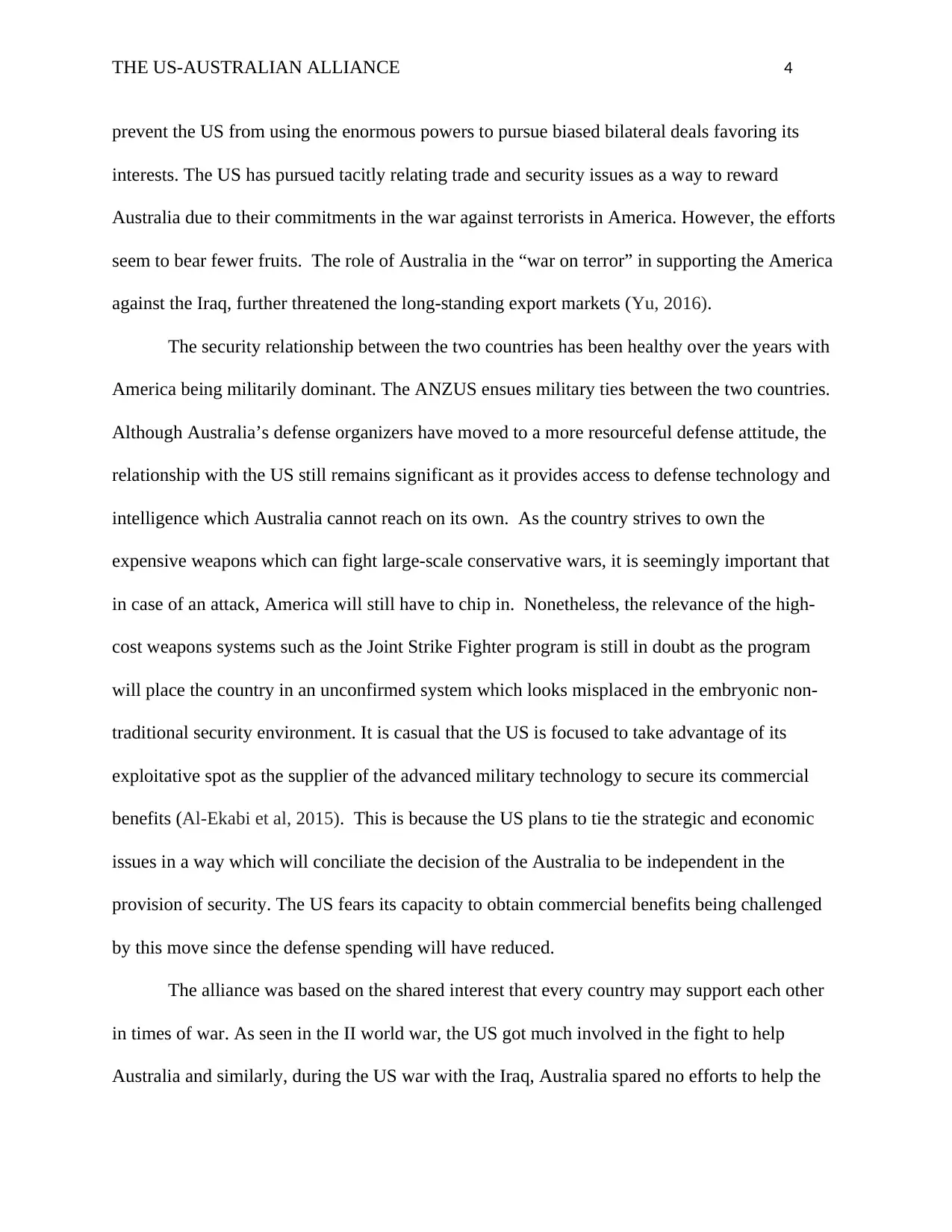
THE US-AUSTRALIAN ALLIANCE 4
prevent the US from using the enormous powers to pursue biased bilateral deals favoring its
interests. The US has pursued tacitly relating trade and security issues as a way to reward
Australia due to their commitments in the war against terrorists in America. However, the efforts
seem to bear fewer fruits. The role of Australia in the “war on terror” in supporting the America
against the Iraq, further threatened the long-standing export markets (Yu, 2016).
The security relationship between the two countries has been healthy over the years with
America being militarily dominant. The ANZUS ensues military ties between the two countries.
Although Australia’s defense organizers have moved to a more resourceful defense attitude, the
relationship with the US still remains significant as it provides access to defense technology and
intelligence which Australia cannot reach on its own. As the country strives to own the
expensive weapons which can fight large-scale conservative wars, it is seemingly important that
in case of an attack, America will still have to chip in. Nonetheless, the relevance of the high-
cost weapons systems such as the Joint Strike Fighter program is still in doubt as the program
will place the country in an unconfirmed system which looks misplaced in the embryonic non-
traditional security environment. It is casual that the US is focused to take advantage of its
exploitative spot as the supplier of the advanced military technology to secure its commercial
benefits (Al-Ekabi et al, 2015). This is because the US plans to tie the strategic and economic
issues in a way which will conciliate the decision of the Australia to be independent in the
provision of security. The US fears its capacity to obtain commercial benefits being challenged
by this move since the defense spending will have reduced.
The alliance was based on the shared interest that every country may support each other
in times of war. As seen in the II world war, the US got much involved in the fight to help
Australia and similarly, during the US war with the Iraq, Australia spared no efforts to help the
prevent the US from using the enormous powers to pursue biased bilateral deals favoring its
interests. The US has pursued tacitly relating trade and security issues as a way to reward
Australia due to their commitments in the war against terrorists in America. However, the efforts
seem to bear fewer fruits. The role of Australia in the “war on terror” in supporting the America
against the Iraq, further threatened the long-standing export markets (Yu, 2016).
The security relationship between the two countries has been healthy over the years with
America being militarily dominant. The ANZUS ensues military ties between the two countries.
Although Australia’s defense organizers have moved to a more resourceful defense attitude, the
relationship with the US still remains significant as it provides access to defense technology and
intelligence which Australia cannot reach on its own. As the country strives to own the
expensive weapons which can fight large-scale conservative wars, it is seemingly important that
in case of an attack, America will still have to chip in. Nonetheless, the relevance of the high-
cost weapons systems such as the Joint Strike Fighter program is still in doubt as the program
will place the country in an unconfirmed system which looks misplaced in the embryonic non-
traditional security environment. It is casual that the US is focused to take advantage of its
exploitative spot as the supplier of the advanced military technology to secure its commercial
benefits (Al-Ekabi et al, 2015). This is because the US plans to tie the strategic and economic
issues in a way which will conciliate the decision of the Australia to be independent in the
provision of security. The US fears its capacity to obtain commercial benefits being challenged
by this move since the defense spending will have reduced.
The alliance was based on the shared interest that every country may support each other
in times of war. As seen in the II world war, the US got much involved in the fight to help
Australia and similarly, during the US war with the Iraq, Australia spared no efforts to help the
Paraphrase This Document
Need a fresh take? Get an instant paraphrase of this document with our AI Paraphraser
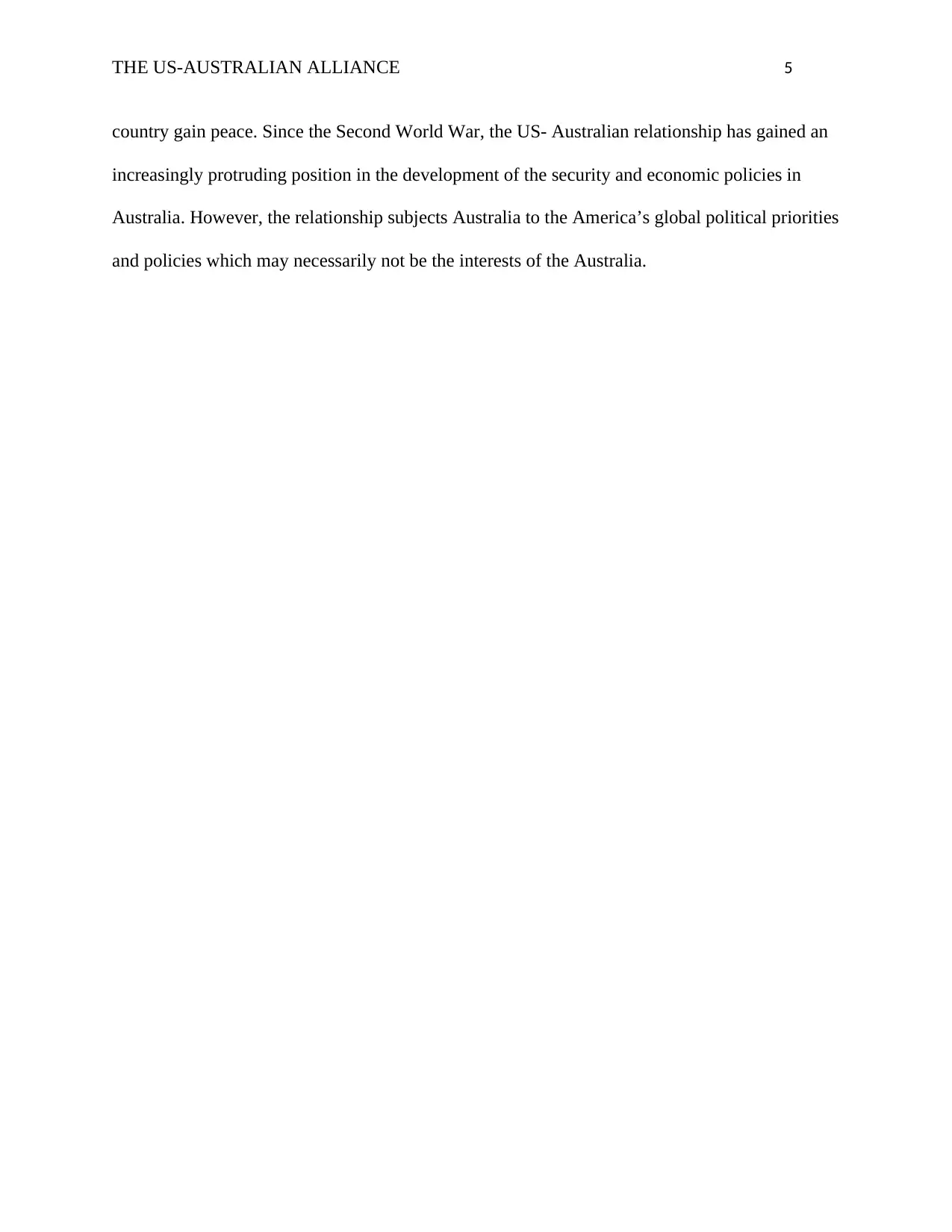
THE US-AUSTRALIAN ALLIANCE 5
country gain peace. Since the Second World War, the US- Australian relationship has gained an
increasingly protruding position in the development of the security and economic policies in
Australia. However, the relationship subjects Australia to the America’s global political priorities
and policies which may necessarily not be the interests of the Australia.
country gain peace. Since the Second World War, the US- Australian relationship has gained an
increasingly protruding position in the development of the security and economic policies in
Australia. However, the relationship subjects Australia to the America’s global political priorities
and policies which may necessarily not be the interests of the Australia.
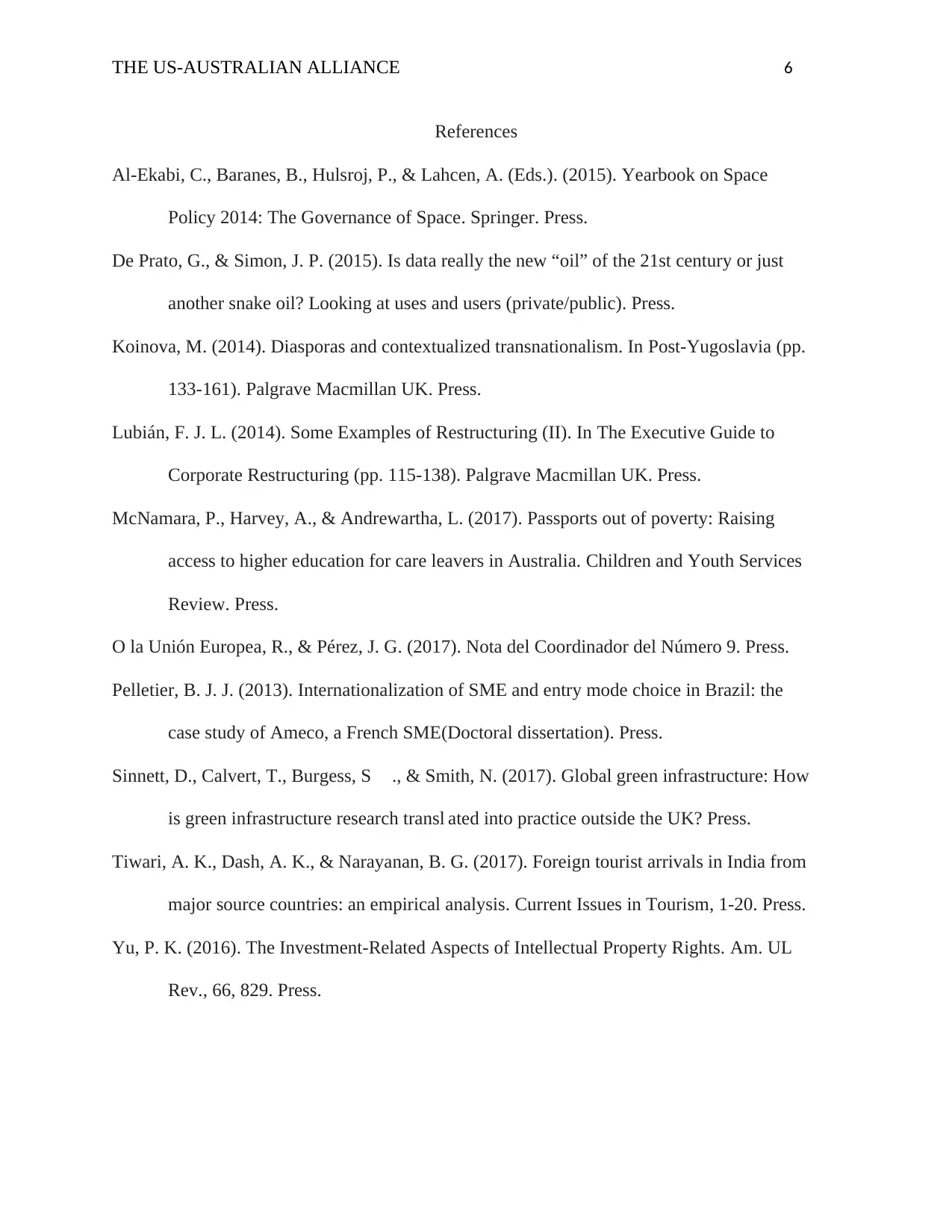
THE US-AUSTRALIAN ALLIANCE 6
References
Al-Ekabi, C., Baranes, B., Hulsroj, P., & Lahcen, A. (Eds.). (2015). Yearbook on Space
Policy 2014: The Governance of Space. Springer. Press.
De Prato, G., & Simon, J. P. (2015). Is data really the new “oil” of the 21st century or just
another snake oil? Looking at uses and users (private/public). Press.
Koinova, M. (2014). Diasporas and contextualized transnationalism. In Post-Yugoslavia (pp.
133-161). Palgrave Macmillan UK. Press.
Lubián, F. J. L. (2014). Some Examples of Restructuring (II). In The Executive Guide to
Corporate Restructuring (pp. 115-138). Palgrave Macmillan UK. Press.
McNamara, P., Harvey, A., & Andrewartha, L. (2017). Passports out of poverty: Raising
access to higher education for care leavers in Australia. Children and Youth Services
Review. Press.
O la Unión Europea, R., & Pérez, J. G. (2017). Nota del Coordinador del Número 9. Press.
Pelletier, B. J. J. (2013). Internationalization of SME and entry mode choice in Brazil: the
case study of Ameco, a French SME(Doctoral dissertation). Press.
Sinnett, D., Calvert, T., Burgess, S ., & Smith, N. (2017). Global green infrastructure: How
is green infrastructure research transl ated into practice outside the UK? Press.
Tiwari, A. K., Dash, A. K., & Narayanan, B. G. (2017). Foreign tourist arrivals in India from
major source countries: an empirical analysis. Current Issues in Tourism, 1-20. Press.
Yu, P. K. (2016). The Investment-Related Aspects of Intellectual Property Rights. Am. UL
Rev., 66, 829. Press.
References
Al-Ekabi, C., Baranes, B., Hulsroj, P., & Lahcen, A. (Eds.). (2015). Yearbook on Space
Policy 2014: The Governance of Space. Springer. Press.
De Prato, G., & Simon, J. P. (2015). Is data really the new “oil” of the 21st century or just
another snake oil? Looking at uses and users (private/public). Press.
Koinova, M. (2014). Diasporas and contextualized transnationalism. In Post-Yugoslavia (pp.
133-161). Palgrave Macmillan UK. Press.
Lubián, F. J. L. (2014). Some Examples of Restructuring (II). In The Executive Guide to
Corporate Restructuring (pp. 115-138). Palgrave Macmillan UK. Press.
McNamara, P., Harvey, A., & Andrewartha, L. (2017). Passports out of poverty: Raising
access to higher education for care leavers in Australia. Children and Youth Services
Review. Press.
O la Unión Europea, R., & Pérez, J. G. (2017). Nota del Coordinador del Número 9. Press.
Pelletier, B. J. J. (2013). Internationalization of SME and entry mode choice in Brazil: the
case study of Ameco, a French SME(Doctoral dissertation). Press.
Sinnett, D., Calvert, T., Burgess, S ., & Smith, N. (2017). Global green infrastructure: How
is green infrastructure research transl ated into practice outside the UK? Press.
Tiwari, A. K., Dash, A. K., & Narayanan, B. G. (2017). Foreign tourist arrivals in India from
major source countries: an empirical analysis. Current Issues in Tourism, 1-20. Press.
Yu, P. K. (2016). The Investment-Related Aspects of Intellectual Property Rights. Am. UL
Rev., 66, 829. Press.
⊘ This is a preview!⊘
Do you want full access?
Subscribe today to unlock all pages.

Trusted by 1+ million students worldwide
1 out of 6
Related Documents
Your All-in-One AI-Powered Toolkit for Academic Success.
+13062052269
info@desklib.com
Available 24*7 on WhatsApp / Email
![[object Object]](/_next/static/media/star-bottom.7253800d.svg)
Unlock your academic potential
Copyright © 2020–2025 A2Z Services. All Rights Reserved. Developed and managed by ZUCOL.





